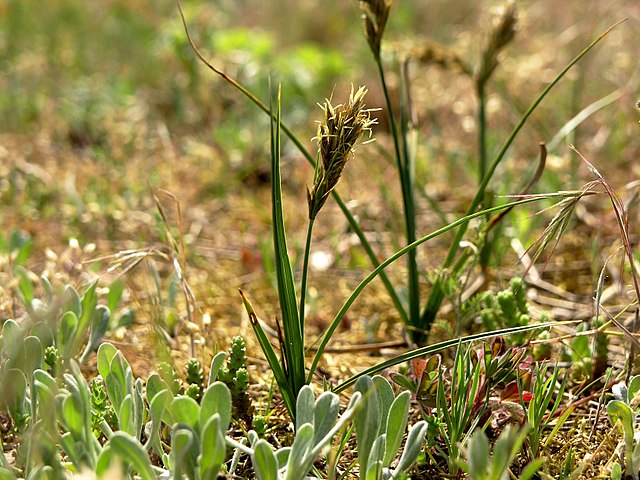 |  |  |  |  |
 |  |
Sand Sedge is a perennial plant with a long (8-10m) lacy root, which is characterized by exfoliation of the bark and a strong smell. New shoots form on the root. The stem of the plants is three-sided, slightly velvety and heavily hairy at the top. The leaves are narrow, linear, hard, sheath-like, velvety with sharp edges. In May-June, new, small, same-sex flowers appear on the shoots. They are placed in an elongated spike of 6-15. The lower flowers on the spike are female, the upper ones are male. Seed - a shell-covered nut.
The underground part of the sedge is used for medicinal purposes - the rhizomes are collected in early spring or late autumn. Before the plant begins vegetation or when it has already finished. The root is cut into small pieces (~10cm) and dried in a shady and well-ventilated place. It is permissible to dry the drug in forced dryers, not exceeding a temperature of 40C. Roots dry slowly, but are prone to rotting, so they should be dried until they become brittle. Ready roots are stored in a dry and dark place for no longer than 3 years.
You should know that in Latvia this plant is found only along the Baltic Sea line!
Saponins, coumarins, glycosides, silicic acid, resins, starch, tannins, very little essential oil and bitter substances are found in the roots.
Medicinal significance
In laboratory studies, valuable saponins have been found in this plant, which are chemically equivalent to the saponins found in the valuable tropical plant - sarsaparilla. Saponins contribute to the dissolution of sputum and their removal from the bronchi, besides, they stimulate the synthesis of corticosteroids, and the regulation of water-salt metabolism has also been observed. The plant also activates thyroid hormones and stimulates the immune system.
Sand Sedge has an antiseptic, bile-repelling, urine-repelling, diaphoretic, analgesic, anti-inflammatory, blood-cleansing, softening and expectorant effect.
The plant is also known in the folk medicine of various countries, especially in Europe (Austria, Bulgaria, Germany, etc.). Decoctions and infusions of the plant root are used in case of colds, severe cough, tracheobronchitis and bronchitis, pneumonia, pulmonary tuberculosis.
Decoctions of sedge are effective in the treatment of diseases of the digestive tract, especially if they are accompanied by diarrhea, intestinal colic, flatulence and constipation. It is also useful to use Sand Sedge in case of gout and rheumatism. Decoctions will also help with endocrine system disorders and bladder diseases.
Sedge sedge decoctions are also used in baths and applications to reduce and treat the manifestations of various skin diseases (psoriasis, eczema, furuncles, red flat scabies, dermatitis of various origins).
Sedge sedge preparations can also be used in case of anemia, as the plant is able to improve blood composition.
In the medicine of various European peoples, bronchitis, pleurisy, constipation, gout and rheumatism are most often treated with the help of sedge. Tea from the above-ground part of the plant improves digestion. Decoctions are recommended to be used externally for the treatment of lupus erythematosus and collagenosis.
Rinse your hair with an emery cloth to stop it from falling out.
